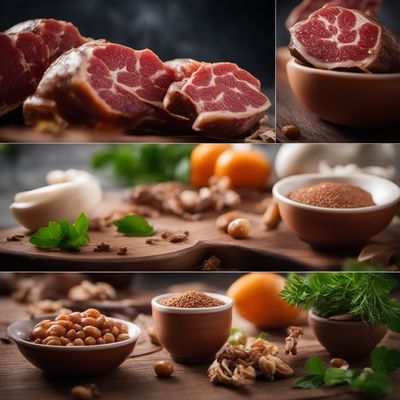
Ingredient
Bovine carcase
The Foundation of Flavor
Bovine carcase refers to the body of a slaughtered cow that is processed for meat consumption. It is characterized by its rich, savory flavor, tender texture, and marbling of fat throughout the muscle fibers. It is used in a wide range of dishes, including roasts, steaks, stews, and ground beef preparations.
Origins and history
The consumption of bovine carcase dates back thousands of years and has been an integral part of various cultures and cuisines. It has played a significant role in the development of traditional dishes and cooking techniques, such as barbecue and slow-cooking methods.
Nutritional information
Bovine carcase is a good source of high-quality protein, essential amino acids, vitamins, and minerals such as iron and zinc. However, it is also higher in saturated fat compared to leaner cuts of meat.
Allergens
Individuals with beef allergies or sensitivities should avoid consuming bovine carcase.
How to select
When selecting bovine carcase, look for cuts that have a bright red color, firm texture, and minimal odor. The meat should be well-marbled with thin, even layers of fat for optimal tenderness and flavor.
Storage recommendations
To maintain the freshness and quality of bovine carcase, store it in the refrigerator at temperatures below 40°F (4°C). Use or freeze the meat within a few days of purchase to prevent spoilage.
How to produce
Amateurs can raise cattle for meat production by providing adequate space, proper nutrition, and veterinary care. However, the process requires significant knowledge and resources.
Preparation tips
Bovine carcase can be prepared using various cooking techniques such as grilling, roasting, braising, or pan-searing. It is important to consider the cut and desired level of doneness to achieve the best results. Resting the meat after cooking allows the juices to redistribute, resulting in a more tender and flavorful dish.
Culinary uses
Bovine carcase is widely used in cuisines around the world, including American, European, Latin American, and Asian dishes. It is the main ingredient in dishes such as steaks, burgers, beef stews, and traditional roasts.
Availability
Bovine carcase is commonly available in countries with a strong tradition of beef consumption, such as the United States, Argentina, Brazil, Australia, and various European nations.
More ingredients from this category » Browse all

Goat carcase
The Wholesome Base

Duck carcase
The Essence of Duck: Unveiling the Secrets of Duck Carcase

Horse carcase
The Noble Beast: Horse Meat

Asses-mules-hinnies carcase
The Forgotten Meat

Chicken carcase
The Foundation of Flavor: Unleashing the Potential of Chicken Carcase

Wild boar carcase
Untamed Bounty: Wild Boar

Sheep carcase
The Art of Lamb: Exploring the Versatility of Sheep Carcass

Goose carcase
The Flavorful Foundation

Turkey carcase
The Versatile Turkey Carcase

Rabbit carcase
The Art of Rabbit: Unlocking the Culinary Potential of Rabbit Carcass

Ratites carcase
The Exotic Delicacy: Ratites Carcase Unveiled

Pig carcase
Pig Carcase: A Versatile Ingredient